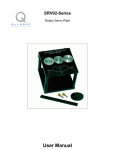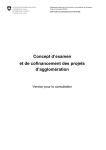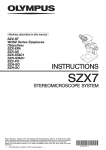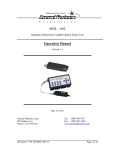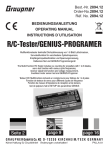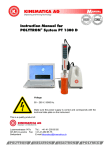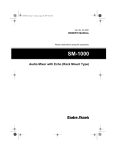Download Operating Instructions Servo Amplifier 2-Quadrant PWM - Q-TECH
Transcript
Servo Amplifier 2-Quadrant PWM for Brushless DC-Servomotors Series BLD 5018 Operating Instructions c om w. fau w w l h er. b a Miniature Drive Systems Micro Drives DC-Micromotors Precision Gearheads Servo Components Drive Electronics Surf to the following Internet address and you will find the latest edition of the instruction manual on-line : www.minimotor.ch/uk/pr/ For direct Download: http://www.minimotor.ch/minicatalog/pdf/DriveCircuits/Manuals/IM_e_BLD_5018.pdf Index Chapter 1. Description page 2 2. Illustration 2 3. Specification 3 4. Dimensions and weight 3 5. 5.1 Safety notes Connection informations 4 4 6. 6.1 6.2 6.3 6.3.1 6.3.2 6.3.3 6.4 6.5 Preparing Control input for turning direction Control input for disable Set value for speed Set value with the internal trimming potentiometer Set value with an external potentiometer Set value with external voltage Adjusting motor current Shut down at overheat 5 5 5 6 6 6 6 6 6 7. 7.1 7.2 7.3 Considerations and procedure Considerations to put the device into operation Considerations to power supply Procedure for calculating the required minimum supply voltage 7 7 8 8 8. Assembly note 9 1 General information 1. Description The devices of the construction line BLD 5018 are 2Q Servo amplifier with electronic commutation for three-phase brushless DC-Servomotors with Hall sensors which are arranged offset at 120°. These Servo Amplifiers assess the rotor position over the integrated hallsensors. The commutation logic controls a MOSFET power stage with high efficiency rate that supplies the specific part winding of the motor. A protection device against thermal overload is integrated. The device can be attached nearby the motor due to the compact module construction line, the result is a better power tracking. The adjustment of the speed set value and speed adaptation also for motor nominal current is to be set by internal potentiometers. Control inputs for the motor turning direction and enable function are included. The connection is by a robust screw terminal. 2. Illustration Figure 1 2 Specifications subject to change without notice Specification & dimensions 3. Specification Power supply Switching frequency Continuous output current @ TA = 22°C BLD 5018-SC2P 20 ÷ 50 20 18 V DC kHz A Analog input command: 1) – Voltage range 0÷5 V DC Logic input TTL Supply voltage for Hall sensors (max. 20 mA) 5 V DC Maximum controllable speed 2) Minimum controllable speed 3) 12 000 800 rpm rpm External inductance 4) 0 ÷ 300 µH Temperature range: – Operating temperature – Storage temperature –10 ... + 45 –40 ... + 85 °C °C 1) Analog input command may be set by an external potentiometer or an external voltage. The maximum controllable speed depends on the power supply, the motor type and the load. The minimum controllable speed depends on the motor type and the load. The appropriate value depends on the operating cycle and working conditions. 2) 3) 4) 4. Dimensions and weight Scale reduced 4 x ø 4,5 Mounting hole 1 1 2 F1 4 3 5 4 6 F2 5 7 5 2 64 3 90 X2 X1 1 1 8 9 F3 9 weight 360 g 5 165 40 170 Figure 2 3 Specifications subject to change without notice Safety notes and connection informations 5. Safety notes Operating voltages exceeding the specified values or reverse-connection will destroy the devices. Unauthorised opening and improper repairs will put the user in danger. If the module is brought from a cold environment into the operating environment, there can be condensation. Wait until the module has reached the right temperature and is absolutely dry before it is put into operation. 5.1 Connection informations 9-pin connector (signals) Plug loading Nr. Printing Description 1 H1 Hall sensor 1 2 H2 Hall sensor 2 3 H3 Hall sensor 3 4 UH Supply voltage for Hall sensors 5 GND Ground connection for Hall sensors 6 Dis Control Input disable (free curcuit) 7 Rev Control Input reverse (turning direction) 8 GND Ground for control and set value input 9 Spd Set value input for speed 5-pol connectors (power) Nr. Printing Description 1 Ub Supply voltage + 2 L1 Motorwinding 1 3 L2 Motorwinding 2 4 L3 Motorwinding 3 5 GND Ground for supply voltage 4 Specifications subject to change without notice Preparing 6. Preparing 6.1 Control input for turning direction (Rev) The control input „Rev“is for changing the turning direction and can be controlled as following: With external switch Open collector transistor With TTL/CMOS module "Rev"not connected or high level "Rev"connected to GND 8 or low level Turning clockwise Turning counter clockwise Direction of rotation can be changed only when motor stopped. 6.2 Control input for disable (Dis) The control input „Dis“is for disabling the unit and can be controlled as following: With external switch Open collector transistor With TTL/CMOS module "Dis"not connected or high level "Dis"connected to GND 8 or low level Motor is turning Motor does not turn Important notice: For stopping the motor it is not advisable to make the set value to 0, but support this through disable. Some motors could otherwise drift shortly. This happens through the integral part of those controllers. 5 Specifications subject to change without notice Preparing 6.3 Set value for speed The set value for the speed can be preset like following: 6.3.1 By the means of the internal trimming potentiometer „speed“ 6.3.2 By the means of an external potentiometer 6.3.3 By the means of external voltage 6.3.1 Set value with the internal trimming potentiometer „speed“ Short circuit between „GND 8“ and „Spd 9“. Turn trimming potentiometer „Speed“ to -: The speed is decreasing Turn trimming potentiometer „Speed“ to +: The speed is increasing 6.3.2 Set value with an external potentiometer The built in trimming potentiometer „Speed“ has to be positioned on – for this. An external potentiometer with 10K is required. The potentiometer is to be connected as following: Start: at „UH4“ End: at „GND 8“ wiper: at „Spd 9“ 6.3.3 Set value with external voltage The built in trimming potentiometer „speed“ has to be positioned on – The external set value is connected as following: Set value GND to „GND 8“ Set value at „Spd9“ Set value voltage = 0V > 0,1V to about 4,5V > 4,5V to about 5V 6.4 Speed Stop Speed according to set value voltage with speed control Motor turns with maximum speed, according the supply voltage and is out of regulating range Adjusting motor current (Imax) The current preset by trimming potentiometer „Imax.“ as following: Type BLD 5018 6.5 Maximum left position 6 -7 A Maximum right position > 18A Shut down at overheat The controller shuts down automatically when the temperature at the inside of the heat sink exceeds 80°C . 6 Specifications subject to change without notice Considerations and procedure 7. Considerations and procedure 7.1 Considerations to put the device into operation Please follow the sequence! 1. Connect Motor to L1, L2 and L3 2. Connect Hall sensors H1, H2, H3 as well as Hall sensor supply to „UH4“ and GND to „GND 5“ from Hall sensors. 3. Connect control inputs according to requirements. 4. Preadjust potentiometer (270°)· At internal set value of the speed turn trimming potentiometer speed to – (short circuit between „GND 8“ and „Spd“) At external set value of the speed turn trimming potentiometer speed to – and connect 0V to „Spd 9“ against „GND 8“. Turn trimming potentiometer Imax. to + Preadjust trimming potentiometer nmax. according to required maximum speed: +: max. speed -: min. speed 5. Connect supply voltage 6. Increase speed set value by Trimming potentiometer or by external set value. As long as the controller is in the active regulating range, the speed can be adjusted by trimming potentiometer speed at a constant external set value. 7. Adjust maximum current with trimming potentiometer Imax. ~4-5A ~6A ~20-22A ~16-17A ~8A ~10A ~12-13A Potentiometer Imax. 7 Specifications subject to change without notice Considerations and procedure 7.2 Considerations to power supply Output voltage: >12V und <Vcc with a residual voltage of <5% Higher voltages will destroy device. Output current: Corresponding to the required torque and possible reserves for acceleration. 7.3 Procedure for calculating the required minimum supply voltage: Default: Operating moment: Operating speed: Rated voltage of motor: Idling speed with UN: Characteristic curve slope: MB nB UN n0 ∆n ∆M Result: Vcc = [mNm] [min -1 ] [V] [min -1 ] [min -1 mNm] UN n0 8 · ( nB + ∆n ∆M · MB ) + 4V Specifications subject to change without notice Assembly note 8. Assembly note Optimum heat dissipation is achieved by mounting the BLD 5018 module on a cooling surface and by the use of a thermal conduction paste. For longer distances between the motor and the control (>30cm), shielded cables should be used for the sensor cable and the motor cable. 9 Specifications subject to change without notice The FAULHABER Group: DR. FRITZ FAULHABER GMBH & CO. KG Daimlerstraße 23 71101 Schönaich · Germany Tel.: +49 (0)7031/638-0 Fax: +49 (0)7031/638-100 Email: [email protected] www.faulhaber.de MINIMOTOR SA 6980 Croglio · Switzerland Tel.: +41 (0)91 611 31 00 Fax: +41 (0)91 611 31 10 Email: [email protected] www.minimotor.ch MicroMo Electronics, Inc. 14881 Evergreen Avenue Clearwater · FL 33762-3008 · USA Phone: +1 (727) 572-0131 Fax: +1 (727) 573-5918 Toll-Free: (800) 807-9166 Email: [email protected] www.micromo.com © MINIMOTOR SA, Switzerland MA15001, english, 1. issue, 11.10.2001












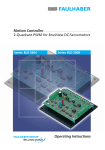
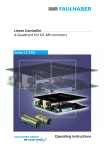
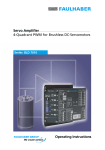
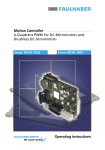

![Final Report - [Almost] Daily Photos](http://vs1.manualzilla.com/store/data/005658230_1-ad9be13b69bd4f2e15f58148160b0f22-150x150.png)
